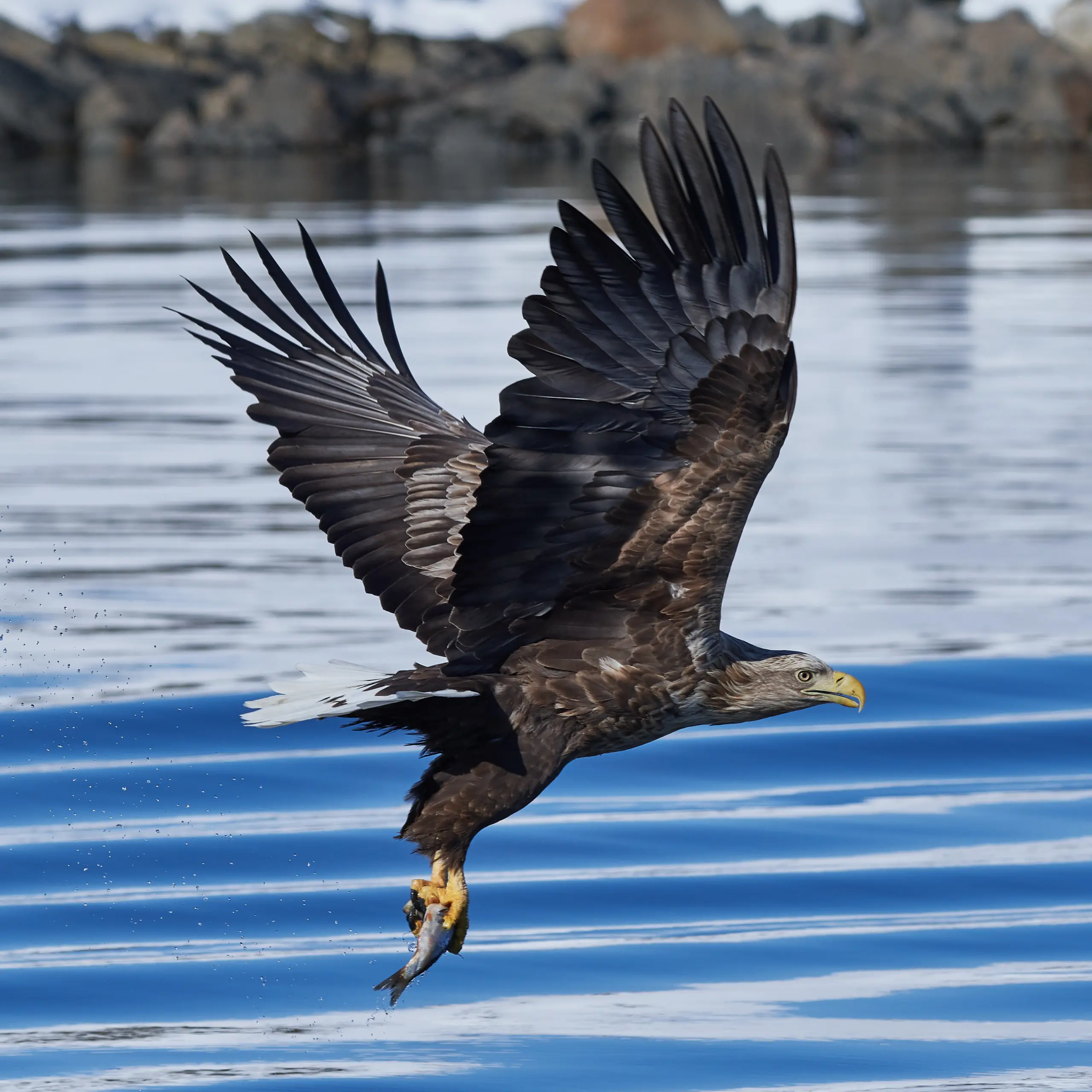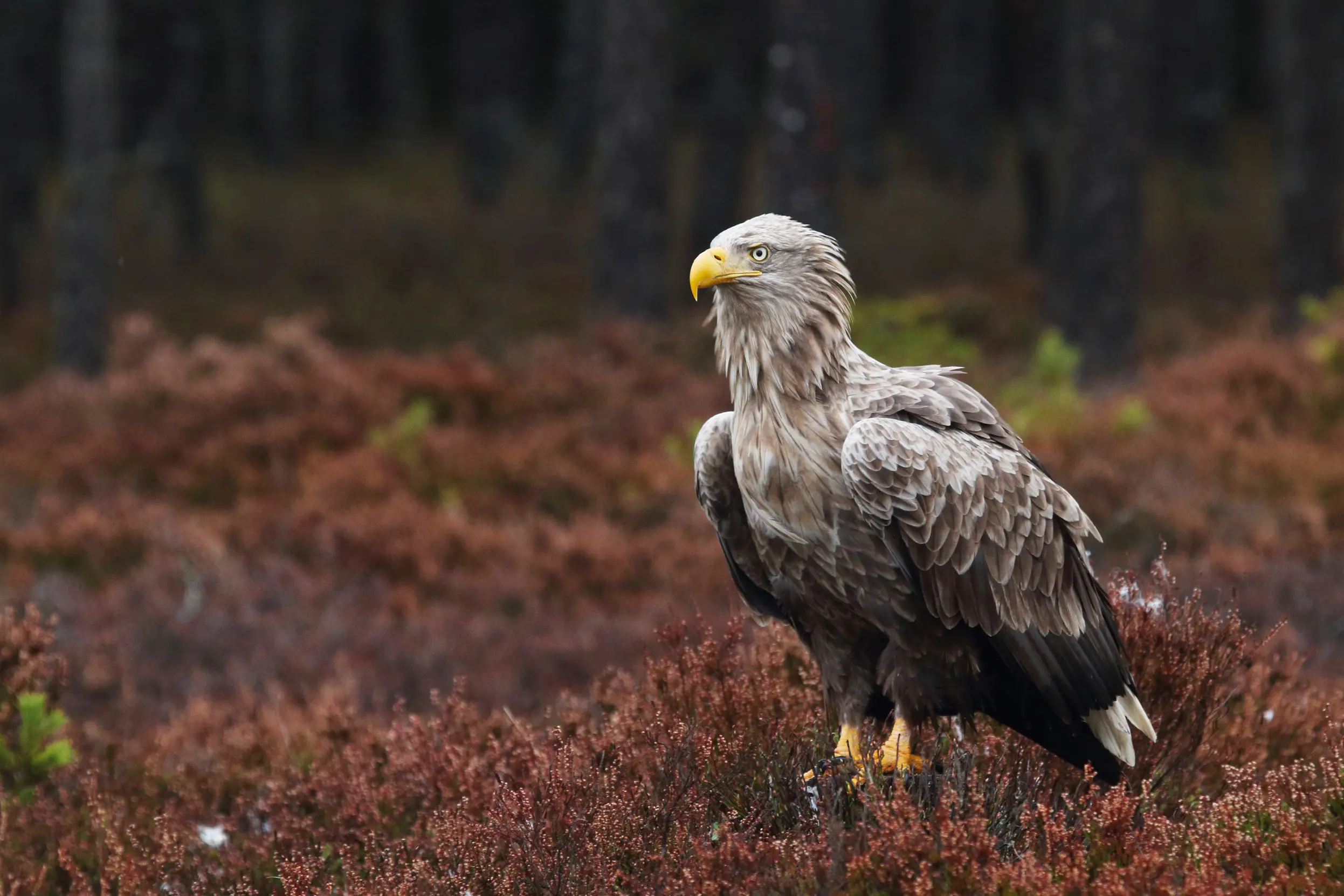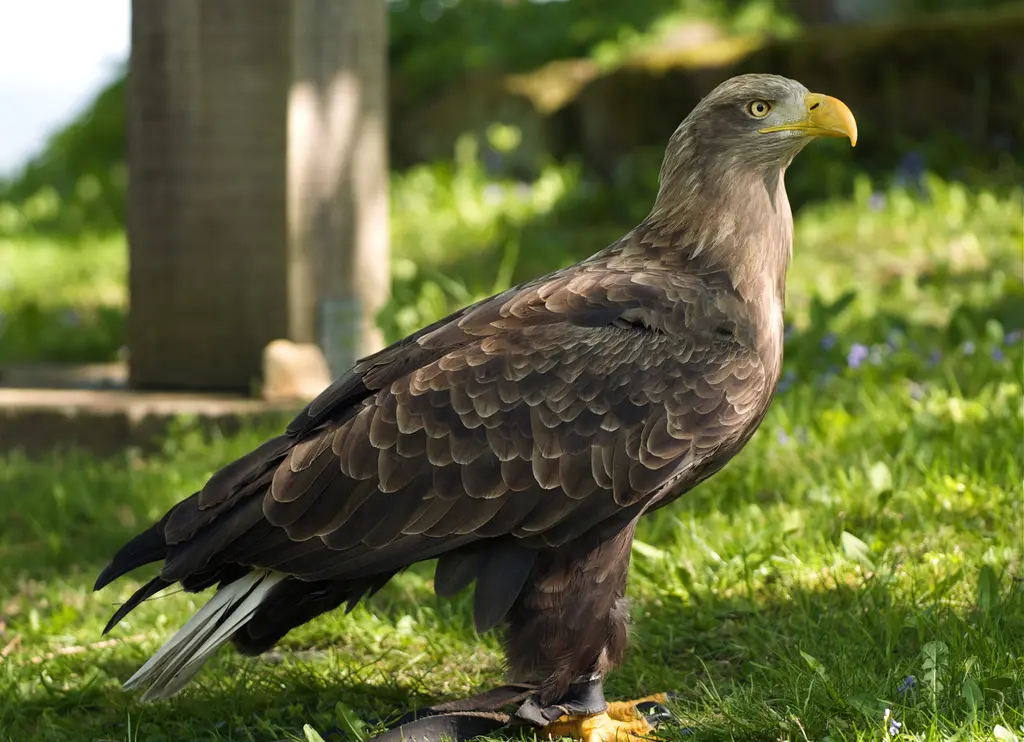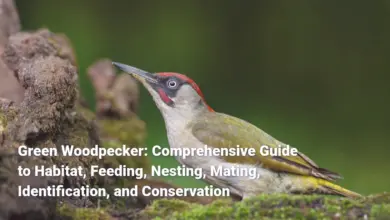White-tailed Eagle: Physical Characteristics, Habitat, Diet, and Cultural Significance
The White-tailed Eagle (Haliaeetus albicilla) stands as a magnificent testament to the natural world, embodying strength, grace, and a fierce independence that inspires awe in those fortunate enough to witness it in flight. Labeled the “flying monarch of the wetlands,” this raptor boasts not only impressive physical traits but also fascinating behaviors that evoke a sense of wonder about life in the skies. This eagle, often seen soaring majestically above lakes and rivers, has a unique presence that captivates the imagination and underscores its importance within the ecosystem.
With a wingspan that can exceed 2.5 meters (approximately 8.2 feet), the White-tailed Eagle is one of the largest raptors in Europe. Its stark white tail and striking coloration distinguish it from its peers, while its role in cultural symbolism transcends geography, making it a hallmark of national pride for many countries. The majestic beauty it exudes is complemented by its position as an apex predator, playing a crucial role in maintaining the ecological balance of its habitat.

Despite its widespread distribution across Europe and Asia, the White-tailed Eagle faces various conservation challenges, including habitat loss and hunting pressures. However, extensive conservation efforts have resulted in its gradual population recovery. In this article, we delve deep into the physical characteristics, habitat preferences, nutritional habits, breeding behaviors, cultural significance, and ongoing research surrounding the White-tailed Eagle, unraveling the complexity and importance of this majestic bird cloaked in mystery and majesty.
Physical Characteristics
The White-tailed Eagle is a magnificent representation of avian evolution, displaying notable physical characteristics that set it apart from other raptors. Serving as one of Europe’s largest birds of prey, this eagle exemplifies robust stature and an impressive wingspan. Its body length typically ranges from 74 to 92 centimeters (approximately 29 to 36 inches), showcasing variability between males and females. Sexual dimorphism is pronounced, with females weighing between 3.7 to 6.9 kilograms (about 8.2 to 15.2 pounds) and males weighing around 3.1 to 5.4 kilograms (approximately 6.8 to 11.9 pounds). The inherent elegance it displays, particularly in flight, underscores the majesty attributed to this species.
Size and Wingspan
The wingspan of the White-tailed Eagle is one of its most striking features, extending impressively between 1.8 to 2.5 meters (approximately 5.9 to 8.2 feet). This substantial wingspan allows the eagle to soar effortlessly, exuding a powerful grace that draws the eye. When in flight, the eagle adopts a broad, flat-winged posture, creating an almost timeless appearance as it glides overhead. In contrast to other eagle species, the White-tailed Eagle’s wings are more rectangular and adapted for soaring, providing it with the stability needed to patrol vast territories in search of food.
The body structure of the White-tailed Eagle comprises strong, sturdy legs adorned with powerful talons an essential adaptation for an apex predator. Its keen eyesight enables it to spot prey from great heights, while its formidable beak, designed to tear flesh, underscores its role as a predator. The remarkable dimensions and robust physical features of the White-tailed Eagle not only facilitate its survival but also create an imposing image.
| Trait | White-tailed Eagle |
|---|---|
| Length | 74 to 92 cm (29 to 36 inches) |
| Weight (Females) | 3.7 to 6.9 kg (8.2 to 15.2 lb) |
| Weight (Males) | 3.1 to 5.4 kg (6.8 to 11.9 lb) |
| Wingspan | 1.8 to 2.5 m (5.9 to 8.2 ft) |
Coloration and Markings
The coloration of the White-tailed Eagle, characterized by a palette of earthy tones, not only serves an aesthetic purpose but also aids in camouflage as it stalks its prey. Adult birds generally display a predominantly dark brown plumage, punctuated by a paler head and a distinctive white wedge-shaped tail that stands out starkly against the rest of the body. Their necks and upper breasts have a lighter, often buff coloration that softens their overall appearance. This striking adult plumage becomes a hallmark for birdwatchers and nature enthusiasts, making the White-tailed Eagle instantly recognizable.
Juvenile eagles, however, differ significantly in coloration. These younger birds appear much darker, with blackish-brown heads and feathers adorned with whitish edges. This muted and shadowy appearance aids in juvenile survival, providing effective concealment as they learn to navigate their environment and hone their hunting skills. It typically takes several years for juvenile eagles to attain the full adult coloration.
In observing these color patterns, it becomes apparent how crucial they are for survival in their respective habitats. The visual characteristics of the White-tailed Eagle enhance its identity and exemplify the evolutionary adaptations that have emerged over time.
| Age Group | Coloration Characteristics |
|---|---|
| Adults | Dark brown body, pale head, white tail |
| Juveniles | Darker plumage, blackish-brown head, whitish edges |
Distinctive Features
Beyond size and coloration, the White-tailed Eagle possesses several distinctive features that define its identity. Key among these is its substantial wingspan that supports its majestic flight and enables it to cover vast territories with ease. Additionally, the eagle’s broad, plank-like wings serve not only for soaring but also for stability while hunting.
Another defining trait is the eagle’s beak a strong, hooked adaptation essential for grasping and tearing apart its prey. The combination of these physical features creates an image of power and prowess, establishing the White-tailed Eagle as a formidable predator in its natural environment.
Furthermore, as the eagle matures, its tail transforms into a wedge shape characterized by a bright white color, providing a stark contrast to its otherwise dark plumage. This unique tail structure is a key identifier and, in many ways, delineates the White-tailed Eagle from other raptors.

In essence, it is the interplay of size, coloration, wingspan, and distinctive features that collectively construct the identity of the White-tailed Eagle a bird both striking in appearance and impressive in the skies.
Habitat and Distribution
The habitat preferences and distribution of the White-tailed Eagle highlight its adaptability and the necessity of conservation efforts for its survival. Predominantly found across Europe and parts of Asia, these raptors favor environments characterized by proximity to water bodies an essential requirement for their foraging and nesting behaviors.
Preferred Environments
White-tailed Eagles thrive in a variety of habitats, reflecting their versatility and adaptability as predators. Below are the primary environments they inhabit:
- Coastal Areas: These environments provide vital resources for hunting fish and scavenging, facilitating the eagle’s diverse diet. Coastal areas are often rich in marine life, allowing for easy access to prey.
- Large Lakes and Rivers: Freshwater bodies play a crucial role in the White-tailed Eagle’s hunting activities. The availability of fish and other aquatic creatures in these habitats ensures a reliable food supply.
- Wetlands and Marshes: These ecosystems not only offer hunting grounds but also serve as suitable nesting sites, protecting young eagles from potential predators.
- Forested Regions: Tall trees are essential for nesting, providing a safe vantage point for adult eagles to monitor their surroundings and protect their young.
The diverse habitat of the White-tailed Eagle underscores its ecological flexibility, allowing these birds to occupy a range of environments in order to thrive.
Global Range
Geographically, the distribution of the White-tailed Eagle spans an extensive range, from northern Greenland and Norway across Europe down to parts of the Indian subcontinent and eastern Asia. In Europe, they primarily inhabit northern regions, making notable populations in countries like Norway, Sweden, Finland, Germany, and Poland.
Meanwhile, the eagle’s presence in Asia signifies its adaptability, as it is found in Siberia and parts of Central Asia, breeding in eastern Russian territories and wintering in milder climates. In many regions, public conservation efforts have played pivotal roles in successfully restoring eagle populations to previous levels.
A chart illustrating habitat and geographical diversity outlines the preferred living conditions and areas inhabited by the species:
| Preferred Environment | Geographic Regions |
|---|---|
| Coastal Areas | Norway, Sweden, Scotland |
| Large Lakes and Rivers | Germany, Finland, Poland |
| Wetlands and Marshes | Eastern Europe |
| Forested Regions | Siberia, Kazakhstan |
Despite their expansive range, the White-tailed Eagle faces particular pressures due to habitat loss and human encroachment. Protection and monitoring of their habitats are vital to sustaining healthy populations and ensuring that these magnificent raptors can continue to thrive in their chosen environments.
Population Density
The current global population of the White-tailed Eagle is estimated to range from 20,000 to 58,400 mature individuals, predominantly concentrated in Europe home to approximately 50-74% of this total. Within Europe, breeding populations are estimated to span from 9,000 to 12,300 pairs, which correlates to approximately 17,900 to 24,500 mature individuals.
Field studies have indicated that areas with abundant aquatic habitats and lower levels of human disturbance foster higher densities of White-tailed Eagles. Conservation efforts have recently had a positive impact on their numbers, leading to their classification as “Least Concern” on the IUCN Red List due to rising populations in several regions.
This recovery signifies the eagle’s ecological importance, primarily in coastal and freshwater ecosystems. As apex predators, White-tailed Eagles significantly influence the biodiversity within these habitats.
| Region | Estimated Population |
|---|---|
| Europe | 17,900 – 24,500 mature individuals |
| Global | 20,000 – 58,400 mature individuals |
Understanding the population dynamics and distribution of the White-tailed Eagle is crucial for effective conservation strategies. Continued efforts are necessary to mitigate threats and preserve their habitats, ensuring this majestic bird remains part of our shared natural heritage.
Diet and Feeding Habits
The diet and feeding habits of the White-tailed Eagle reveal a fascinating aspect of its lifestyle, showcasing its role as an apex predator and scavenger within various ecosystems. This eagle exhibits a remarkable adaptability toward its diet, allowing it to thrive across diverse habitats.
Main Prey Species
The primary dietary components of the White-tailed Eagle predominantly include fish and waterfowl, reflecting its aquatic hunting prowess. The following species are essential to their diet:
- Fish: The White-tailed Eagle is an expert piscivore, often hunting species such as salmon, trout, herring, carp, and perch. Their hunting patterns involve gliding low over water, utilizing keen eyesight to spot potential prey before swooping down to catch it.
- Waterfowl: Ducks, geese, swans, coots, and grebes represent a significant portion of their diet, particularly during the breeding season when these birds are most abundant. The White-tailed Eagle employs various hunting techniques to secure these prey, including ambush strategies and opportunistic stalking.
- Opportunistic Scavenging: This eagle is not purely a hunter; it is also an adaptable scavenger. In the winter months, when food sources may become scarce, White-tailed Eagles rely on carrion from various animals, including deer, sheep, rabbits, hares, and even seals. This behavior is crucial for survival during times of low prey availability.
- Kleptoparasitism: White-tailed Eagles are known to partake in kleptoparasitism, where they steal food from other birds, such as gulls and ospreys. This opportunistic feeding behavior supplements their diet without the need for additional energy expenditure on hunting.
The adaptability of the White-tailed Eagle’s diet is remarkable, allowing it to thrive in diverse ecological conditions. Notably, the interdependence of available prey within its habitat is a crucial aspect of its survival.
| Diet Component | Examples |
|---|---|
| Fish | Salmon, trout, herring |
| Waterfowl | Ducks, geese, swans |
| Carrion | Deer, sheep, rabbits |
Hunting Techniques
The hunting techniques of the White-tailed Eagle highlight its position as an apex predator within its environment. This bird exhibits a range of strategies to catch prey, emphasizing its adaptability and skillful methods.
- Plunge Diving: When hunting for fish, the eagle often employs a technique known as “plunge diving.” It flies low over the water’s surface, sometimes hovering briefly before plunging down. This method allows the eagle to catch fish by surprise, ensuring a successful catch.
- Wading: In shallow waters, White-tailed Eagles may even wade to catch fish, utilizing their powerful legs and talons to snatch potential prey directly from the water.
- Stealth and Stalking: When pursuing waterfowl, they may use stealth and stalking tactics, approaching silently to catch their prey off guard. This method enables them to surprise their targets effectively, particularly in habitats where the prey may be abundant.
- Kleptoparasitism Strategy: Engaging in kleptoparasitism not only allows the eagle to supplement its diet with less energy expenditure but also showcases its opportunistic nature in competitive environments.
The versatility in hunting style reflects the adaptability of the White-tailed Eagle as predators, ensuring their survival in varied ecological contexts.
Seasonal Diet Variation
Dietary variations occur seasonally, significantly influencing the white-tailed eagle’s nutritional needs. These changes can depend on environmental shifts and availability of prey species in specific geographic locations.
- Summer Months: During the warmer months, especially in coastal environments, fish dominate their diet. Species such as salmon and herring become staples due to their abundance in these habitats.
- Winter Months: As temperatures drop and fish stocks diminish, the eagle’s feeding habits shift towards more terrestrial animals, including small mammals and carrion. This seasonal dietary flexibility is essential for surviving harsh winters when aquatic hunting becomes challenging.
- Regional Differences: In diverse geographic regions, the composition of their diet may shift uniquely. For example, northern populations may rely more heavily on fish, whereas inland populations may consume more birds and mammals.
- Carrion Utilization: Studies indicate that carrion can make up to 30% of the diet during winter months in certain regions, particularly areas where fish become less accessible.
The dietary flexibility of the White-tailed Eagle serves not only as a survival strategy but also plays a significant role in regulating ecosystems as they shift between predation and scavenging.
Breeding and Nesting
The breeding and nesting habits of the White-tailed Eagle are integral components of its life cycle, reflecting the bird’s commitment to its young and responsibility in nurturing future generations.
Mating Rituals
Mating rituals among White-tailed Eagles are characterized by complex courtship displays, which not only strengthen bonds between pairs but also play a critical role in establishing territory. During the breeding season, typically in early spring, pairs often engage in aerial displays that include soaring, sky-dancing, and synchronized maneuvers. The dramatic cartwheeling, talon-touching, and vocalizations help reinforce their pair bond and assert dominance over their chosen territory.
These rituals highlight the significance of social interaction in reinforcing long-term partnerships. Mated pairs usually remain together for life, returning to the same nesting sites year after year, strengthening their bond through mutual reliance.
Nest Construction
Nest construction is an essential aspect of the White-tailed Eagle’s breeding cycle, as they build large nests, typically located in tall trees or cliffs. These nests can measure several meters across and may be constructed using sticks, branches, and other vegetation. Over time, pairs often add to their nests, resulting in structures that may weigh several tons.
The building process typically starts in late March or early April, with females primarily responsible for laying the eggs. The breeding season varies depending on the region; in southern areas, it may extend from January to July, while in northern regions, it may occur from April to September.
Breeding sites are vital for ensuring the survival of their young, requiring ideal conditions that are safe from potential predators. The nesting area’s elevated status allows adult eagles to monitor their environment and defend against threats.
Parental Care
Once the eggs hatch, both parents share the responsibility of caring for their young, known as eaglets. The eaglets are born covered in creamy white down and start moving around the nest approximately ten days post-hatching. They typically fledge at around 70 to 75 days; however, they remain dependent on their parents for food and guidance for an additional 5 to 6 weeks.
The parental investment extends beyond feeding; both the male and female actively protect and educate the fledged eaglets, enhancing their survival chances. Observations within populations have revealed that dedicated parenting plays a crucial role in the overall health of the eagle population, influencing their long-term success in breeding.
In summary, the reproductive strategies, intricate mating rituals, substantial care for their young, and robust nesting habits of the White-tailed Eagle highlight the species’ adaptability and commitment to ensuring their species’ continuation in the wild.
Cultural Significance
The White-tailed Eagle’s cultural significance is widely recognized across various regions, often illustrated through mythology and local folklore. These majestic birds have left indelible marks on human societies and culture throughout history.
Symbols in Mythology
In many cultures, the White-tailed Eagle is revered as a powerful symbol. In Poland, for instance, this bird serves as a national emblem, encapsulating the spirit of resilience and independence that reflects the nation’s tumultuous history. The eagle is deeply embedded in Polish identity, symbolizing pride, strength, and freedom.
Beyond Polish folklore, the eagle is often perceived as a messenger between the earth and the heavens, connecting the physical and spiritual realms. In various Native American cultures, the eagle embodies qualities of strength, courage, and wisdom. It is seen as a guide and protector, offering spiritual assistance and reinforcing human connection to nature.
The symbolism surrounding the White-tailed Eagle extends to themes of vision and clarity. Renowned for its exceptional eyesight and soaring abilities, it becomes a metaphor for wisdom and insight, often linked with elevated perspectives and understanding of the world. In Celtic mythology, the eagle is often portrayed as a messenger of the divine, reflecting not only physical prowess but also spiritual insight.
| Cultural Significance | Example |
|---|---|
| National Symbol | Poland |
| Spiritual Messenger | Native American Cultures |
| Wisdom and Insight | Various Mythologies |
Impact on Local Communities
The presence of the White-tailed Eagle in various regions evokes community pride and enhances cultural heritage. Its historical significance coupled with contemporary conservation efforts fortifies local identities attached to this majestic bird. As conservation initiatives progress, communities often engage in educational programs that highlight the importance of plant and animal biodiversity, fostering a deeper understanding and appreciation for these birds.
Restoration efforts, particularly in areas where the eagle has been reintroduced, have a considerable impact on local economies. The White-tailed Eagle has become a focal point for eco-tourism, drawing visitors eager to catch a glimpse of this magnificent raptor in its natural habitat. Regions that successfully implement ecotourism ventures often witness corresponding economic growth, as wildlife tourism generates revenue for local businesses, such as accommodations and guided tours.
By highlighting the cultural significance and ecological role of the White-tailed Eagle, communities become more involved in conservation efforts, ultimately fostering a symbiotic relationship between local populations and their natural environment. Through these intertwined narratives, the eagle emerges not only as a natural predator but also as a symbol of hope and resilience, connecting generations through shared values and experiences.
Role in Ecotourism
The White-tailed Eagle plays a crucial role in promoting ecotourism, particularly in regions where its populations have experienced successful reintroduction. The presence of these magnificent birds often attracts eco-tourists and wildlife enthusiasts, leading to new economic opportunities for local communities.
For example, in the Isle of Wight, stakeholders have recognized the potential of these eagles to boost tourism. The carefully managed reintroduction programs have brought about increased revenue through wildlife tourism, where visitors travel from afar to witness the eagle soar majestically over their landscapes. Additionally, local businesses, such as shops, hotels, and food services, often benefit from the influx of tourists seeking experiences centered around the White-tailed Eagle.

Similarly, in Scotland, the reintroduced population of White-tailed Eagles has contributed millions to the local economy via wildlife tourism, providing substantial economic opportunities for guiding services and local markets. Guided tours focused on eagle watching often pique the interest of visitors, bringing attention to the importance of conservation naturally.
The importance of the White-tailed Eagle in ecotourism extends beyond economic benefits educational initiatives surrounding the species engage the local community and create awareness about the ecological roles these eagles play. Such involvement ensures that conservation practices thrive, fostering a deeper connection between communities and these remarkable birds while enhancing the overall biodiversity of the area.
In essence, the White-tailed Eagle stands as a cultural and ecological emblem, enriching communities through its existence and inspiring sustainable biodiversity conservation efforts.
Research and Studies
Recent research and studies concerning the White-tailed Eagle (Haliaeetus albicilla) illuminate many aspects of their biology, ecology, and conservation. These insights reveal critical findings related to habitat use, breeding behaviors, and public perceptions of conservation efforts.
Recent Findings
Recent studies have utilized various methodologies and technologies, including satellite telemetry, to enhance our understanding of the White-tailed Eagle’s habitat utilization and behaviors.
- Habitat Use and Selection: A study conducted in Finland demonstrated that post-fledging White-tailed Eagles exhibited preferences for habitats rich in wetlands and forests while avoiding urbanized and agricultural areas. These findings underscore the necessity of preserving natural habitats for the survival of these eagles, especially during vulnerable life stages.
- Nest Success and Growth: In Japan, a longitudinal study along the Teshio River tracked nest success rates, revealing an increase in successful nests from two to nine over an extended period. Factors contributing to this growth included enhanced habitat quality and targeted conservation measures aimed at supporting nesting sites.
- Public Perceptions: Research investigating public sentiments regarding the reintroduction of White-tailed Eagles indicated a growing acceptance and support for conservation efforts. As people become more involved in awareness campaigns, they develop a sense of ownership and responsibility towards local wildlife.
- Anthropogenic Threats: Emerging studies have outlined the ongoing threats faced by White-tailed Eagles, particularly in relation to habitat loss from expanding human activities. Conservation initiatives in Finland aim to safeguard nest sites amid increasing infrastructure development, emphasizing the need for careful land-use planning.
The wealth of data gathered through tri-fold research approaches not only contributes to the understanding of the White-tailed Eagle’s ecology but also informs effective management and conservation strategies.
| Research Focus | Key Findings |
|---|---|
| Habitat Use | Preference for wetlands and forests |
| Nest Success | Increased successful nests in Japan |
| Public Perceptions | Growing support for conservation |
| Anthropogenic Threats | Habitat loss from human activities |
Ongoing Research Projects
Ongoing research projects centered on the White-tailed Eagle involve various aspects, focusing on tracking movements and habitat preferences while understanding community perspectives related to their conservation.
- Tracking and Monitoring: The reintroduction project led by organizations such as the Forestry England and the Roy Dennis Wildlife Foundation utilizes satellite telemetry to monitor the movements and behavior of the White-tailed Eagles. This data allows researchers to gain valuable insights into habitat preferences, survival rates, and territory exploration patterns.
- Breeding Success Studies: A notable area of research focuses on monitoring the first successful fledging of White-tailed Eagle chicks in England in 2023. Such phenomena provide insights into the effectiveness of reintroduction strategies and the adaptation of these eagles to their surroundings, underscoring the significance of breeding and social behavior in managing future releases.
- Assessing Public Engagement: Ongoing research assessing public attitudes toward the reintroduction and conservation of White-tailed Eagles has identified increased support since initial surveys. Engaging community members raises awareness, fosters positive relationships, and enables citizen involvement in conservation efforts.
- Longitudinal Studies on Habitat Utilization: Continued observation and data collection are vital for comprehensively understanding changes in habitat use based on human development and climate fluctuations. Evaluation of habitat choices helps to inform conservation strategies needed to enhance the sustainability of the White-tailed Eagle population.
These research initiatives collectively emphasize preparedness for addressing potential ecological challenges faced by White-tailed Eagles, allowing informed decisions to shape successful conservation practices.
Importance of Observation
The importance of observation in conservation efforts surrounding the White-tailed Eagle cannot be overstated. Active engagement in monitoring populations, behaviors, and changing habitats ultimately fosters a thriving ecological balance.
- Understanding Behaviors: Observation provides insights into the behaviors and nesting preferences of White-tailed Eagles. Effective monitoring allows for a better understanding of their life cycles, migration patterns, and feeding habits essential components for effective conservation strategies.
- Public Participation in Conservation: Engaging the public in observation enhances community awareness and responsibility toward local wildlife. Citizen science initiatives encourage residents to report sightings and gather data, contributing valuable information to ongoing research and conservation efforts.
- Evaluating Conservation Success: Continuous observation of populations and habitats allows researchers and conservationists to evaluate the success of initiatives aimed at reintroducing White-tailed Eagles to areas where they have previously been absent for decades. Careful monitoring aids in identifying potential challenges that may arise during reintroduction efforts, allowing for adaptive strategies that bolster success.
- Adaptive Management: By fostering a culture of observation, conservationists promote adaptive management strategies. Observational data aids in adjusting strategies to mitigate threats and enhance habitat recovery necessary for sustaining healthy populations of White-tailed Eagles.
In conclusion, the importance of observation in relation to the White-tailed Eagle transcends mere academic interest; it strengthens community involvement, drives conservation, enhances ecological understanding, and plays a pivotal role in ensuring this magnificent bird thrives in its natural habitat.
Comparison with Other Eagles
The White-tailed Eagle can be effectively compared with other notable eagle species, such as the Bald Eagle (Haliaeetus leucocephalus) and the Golden Eagle (Aquila chrysaetos). These comparisons shed light on their similarities and differences across several parameters, enriching our understanding of this remarkable family of birds.
Similar Species
- Bald Eagle:
- Size and Mass: The White-tailed Eagle is generally larger than the Bald Eagle, boasting a wingspan of about 1.78 to 2.45 meters (5 ft 10 in to 8 ft 0 in) compared to the Bald Eagle’s approximately 1.8 to 2.3 meters (5.9 to 7.5 ft).
- Appearance: The distinctive wedge-shaped white tail of the White-tailed Eagle contrasts sharply with the Bald Eagle’s white head and tail, which form its iconic look. Both species exhibit brown plumage but differ in specific visual characteristics.
- Diet: Both eagles can be found near aquatic environments; however, the White-tailed Eagle has a stronger piscivorous focus while the Bald Eagle is more inclined to scavenge on carrion and other non-fish food sources.
- Golden Eagle:
- Size and Mass: Although generally smaller than the White-tailed Eagle, the Golden Eagle exhibits impressive agility in the air. The weight range differs slightly, with the White-tailed Eagle weighing from 3.1 to 6.9 kg (6.8 to 15.2 lb).
- Appearance: The Golden Eagle possesses dark brown feathers decorated with golden-brown highlights on the head and neck. The wedge-shaped tail of the White-tailed Eagle starkly contrasts its earthy tones.
- Flight Patterns: Golden Eagles demonstrate a more agile flight style characterized by quick, shallow wing beats, while White-tailed Eagles glide gracefully, showcasing their powerful wings that allow them to soar over their habitats efficiently.
By examining both similarities and differences among these species, we can appreciate the diverse adaptations and ecological roles that eagles encompass in their habitats.
| Comparison Aspect | White-tailed Eagle | Bald Eagle | Golden Eagle |
|---|---|---|---|
| Size & Wingspan | 1.78 to 2.45 m (5 ft 10 in to 8 ft) | 1.8 to 2.3 m (5.9 to 7.5 ft) | Up to 2.3 m (7 ft 7 in) |
| Distinct Features | White tail, dark brown plumage | White head & tail, brown body | Golden highlights, broad wings |
| Primary Diet | Fish, waterfowl | Fish, scavenging | Small mammals, birds |
Unique Traits
- Specialized Diet: The White-tailed Eagle exhibits a higher specialization to aquatic environments, predominantly preying on fish, indicating evolutionary adaptations not as pronounced in other eagle species.
- Kleptoparasitic Behavior: While kleptoparasitism is apparent in various eagle species, the White-tailed Eagle tends to engage in this behavior more frequently, indicating its adaptability to faster changing environmental conditions.
- Nesting Patterns: White-tailed Eagles often reuse and expand their nests over time, resulting in expansive structures as compared to other eagles that may have varying nesting habits, with these larger nests further connecting them with their ecological requirements.
In synthesizing all these comparative aspects, the White-tailed Eagle stands out, not merely as one of Europe’s largest eagles, but as a vital predator within its ecosystem, defined by unique adaptations and cultural significance.
Ecological Role
The ecological role of the White-tailed Eagle showcases its importance as an apex predator and scavenger, paralleling the functions of similar species while exemplifying its unique niche.
- Apex Predator: White-tailed Eagles exert significant control over populations of fish and waterfowl, playing a crucial role in regulating these species’ numbers within their ecosystems similar to the Golden Eagle’s influence on terrestrial prey.
- Nutrient Recycling: By scavenging, the White-tailed Eagle contributes to nutrient recycling within its habitat, enhancing ecosystem health. This feature mirrors the ecological significance of Bald Eagles utilizing carrion, maintaining biodiversity through adaptive feeding behaviors.
- Adaptation and Survival: Notably, the capacity of the White-tailed Eagle to adapt its diet and hunting techniques allows it to thrive in mixed environments, demonstrating ecological resilience amid human-induced changes.
In conclusion, while sharing common ecological roles as natural predators, the White-tailed Eagle’s specialized adaptations significantly contribute to its distinctive identity among other eagles, enhancing our understanding of wildlife in ecological interdependence.









